Charles E W Bean, Diaries, AWM38 3DRL 606/254/1 - 1917 - 1933 - Part 13
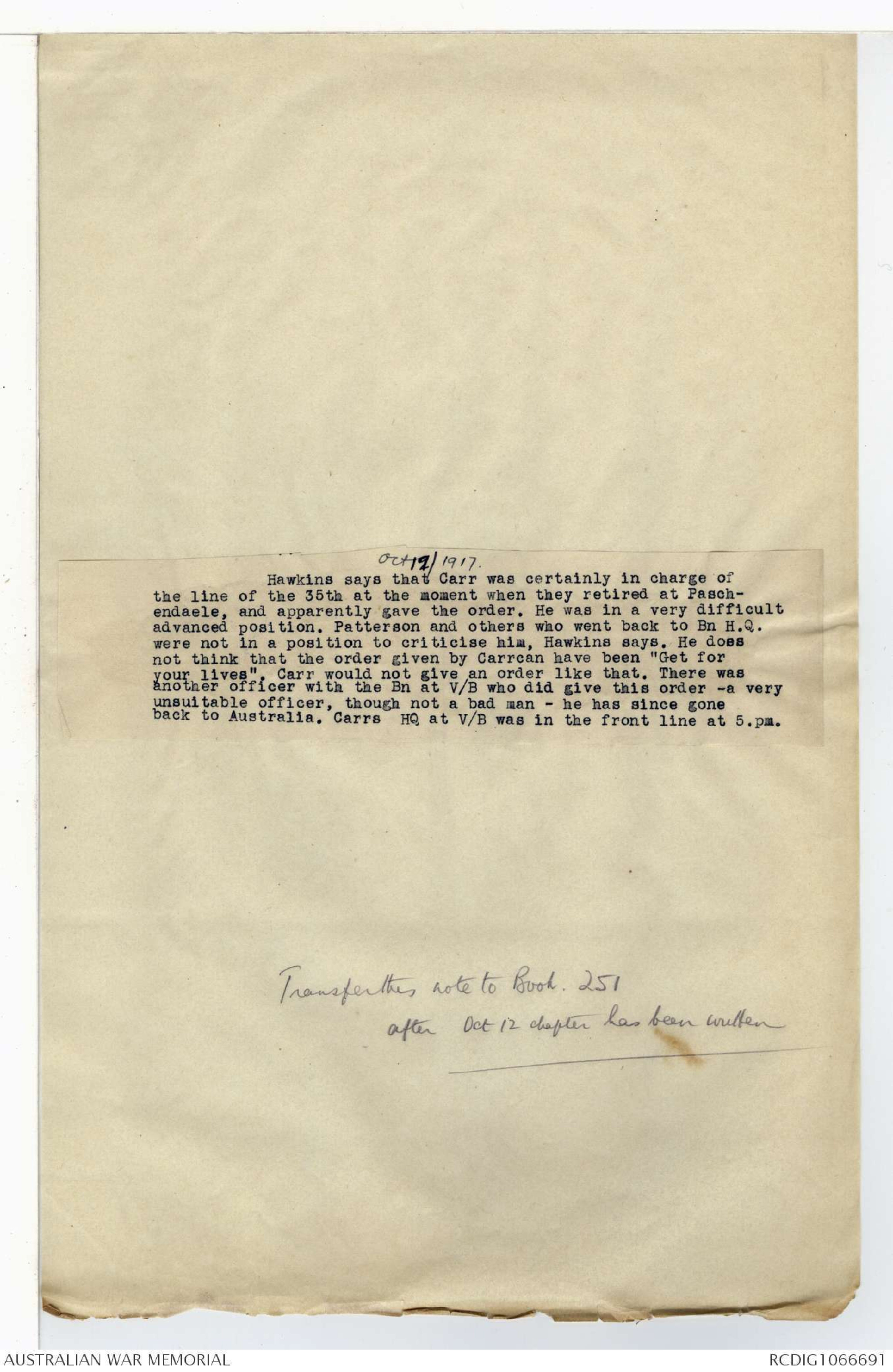
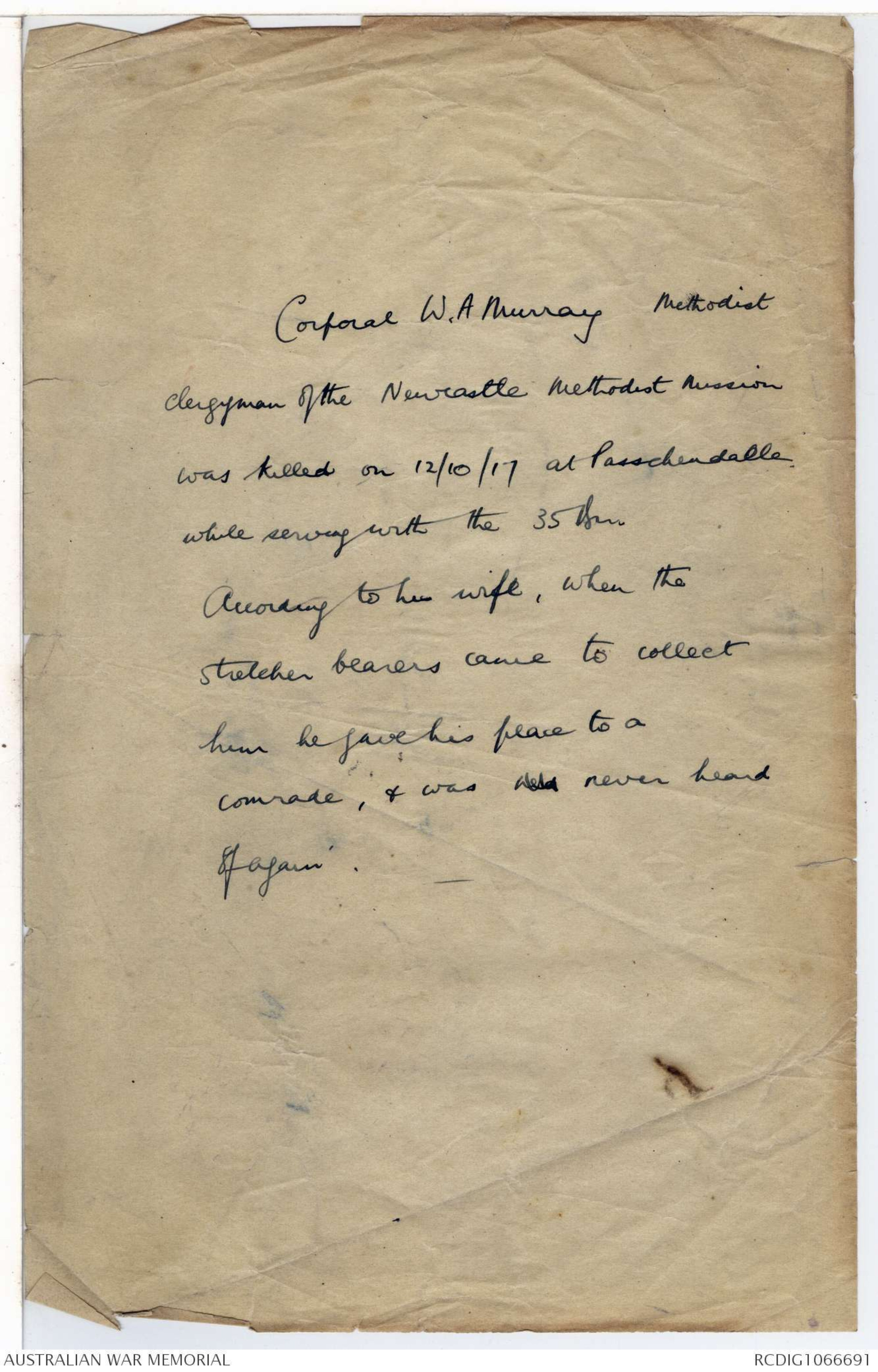
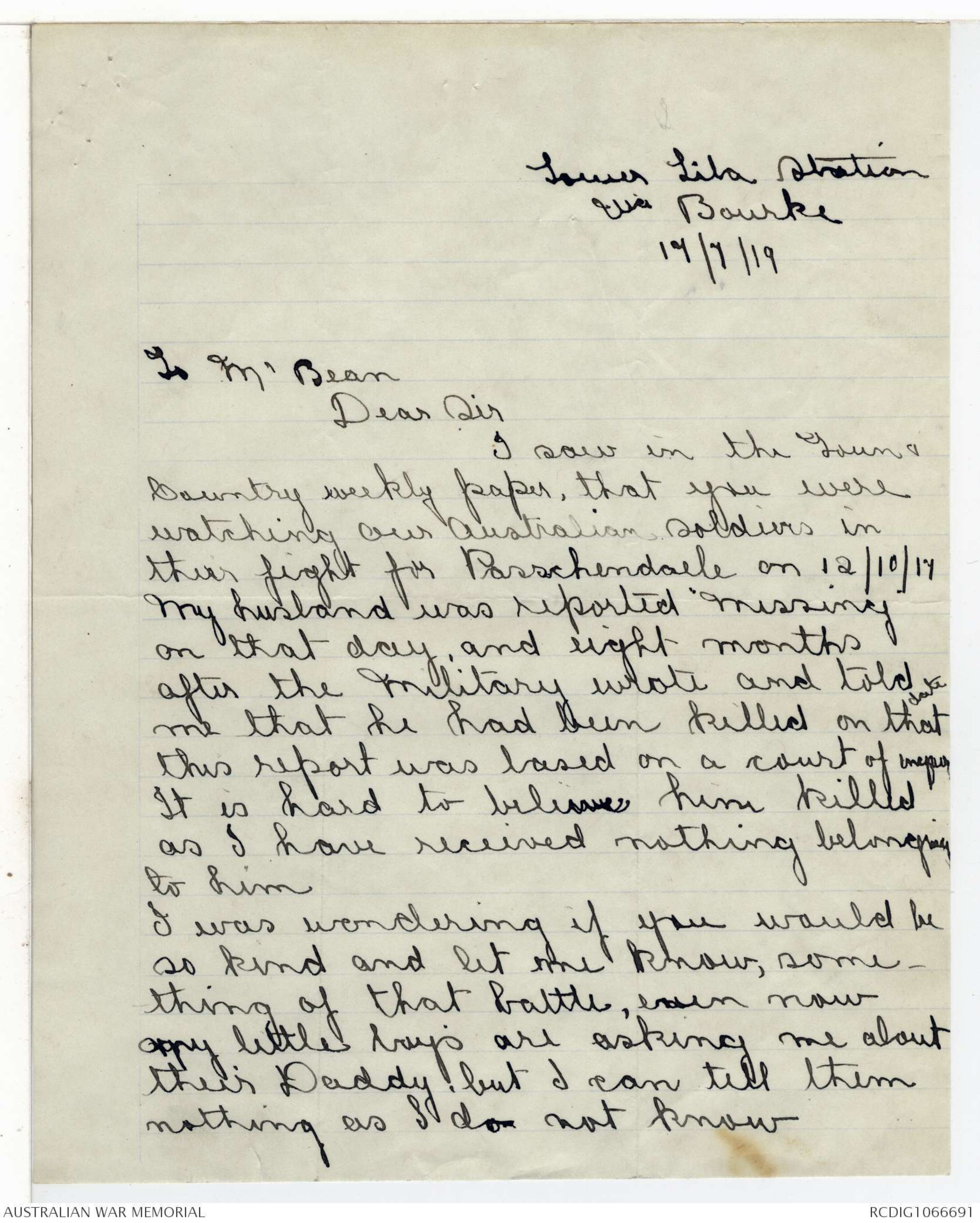
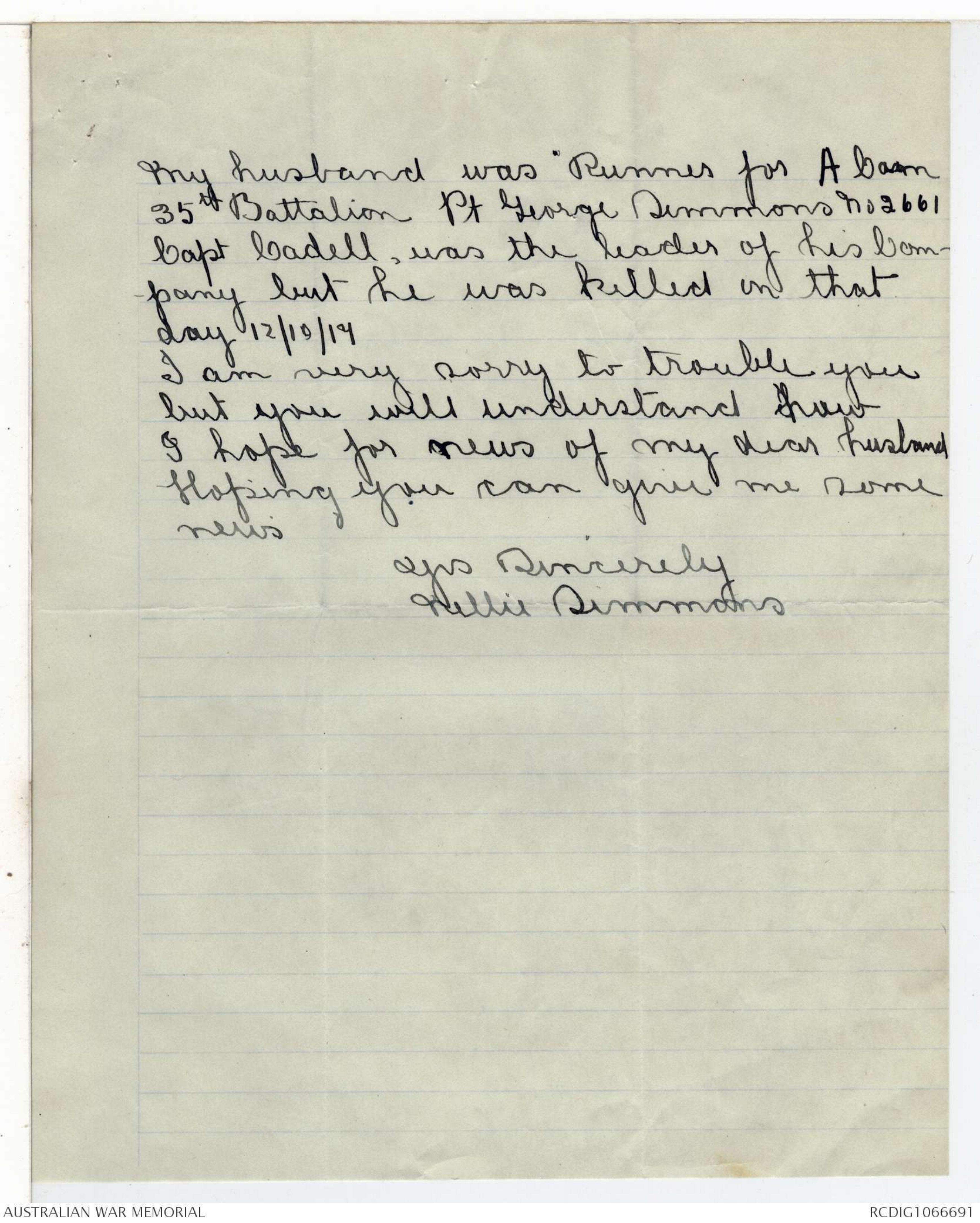
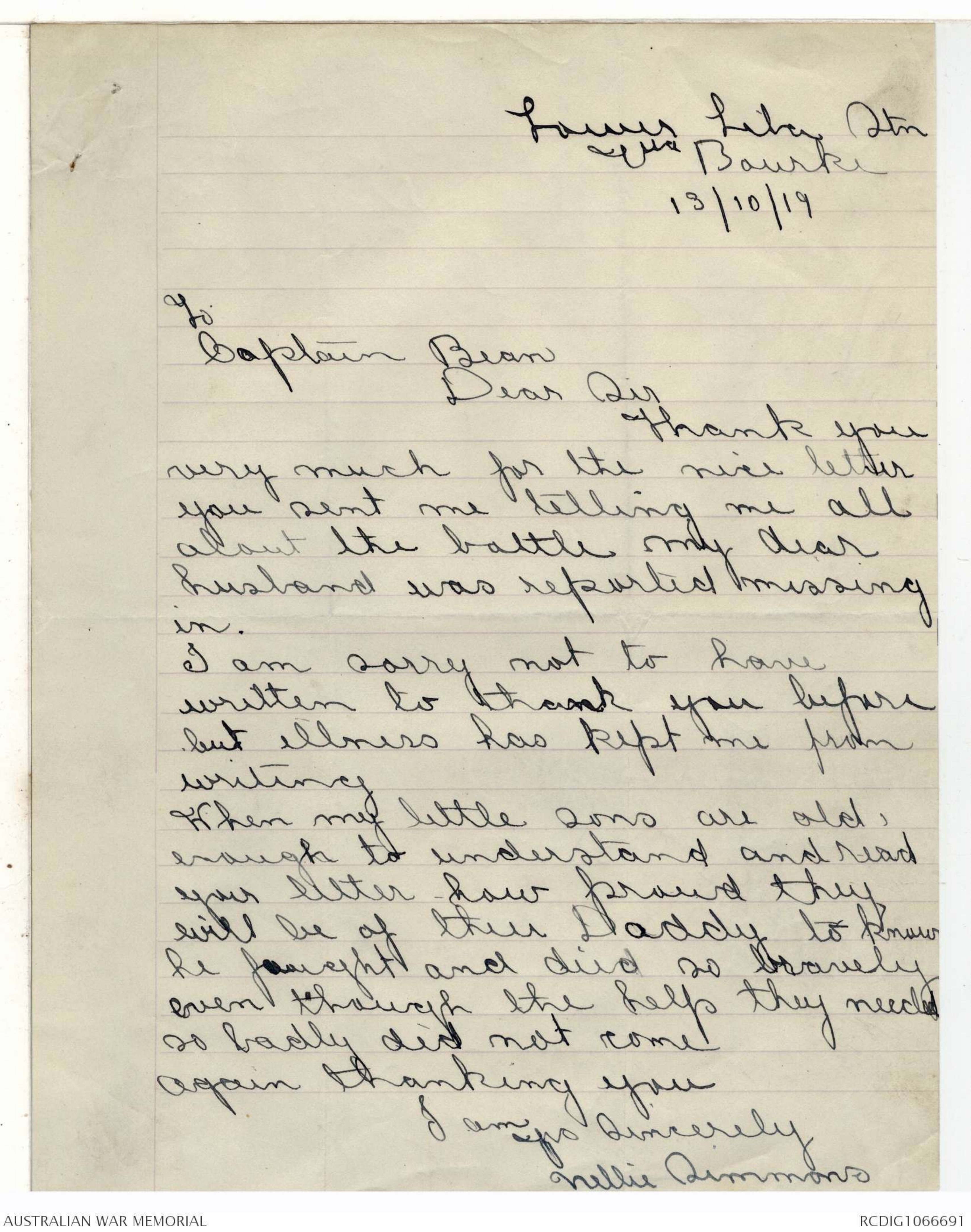
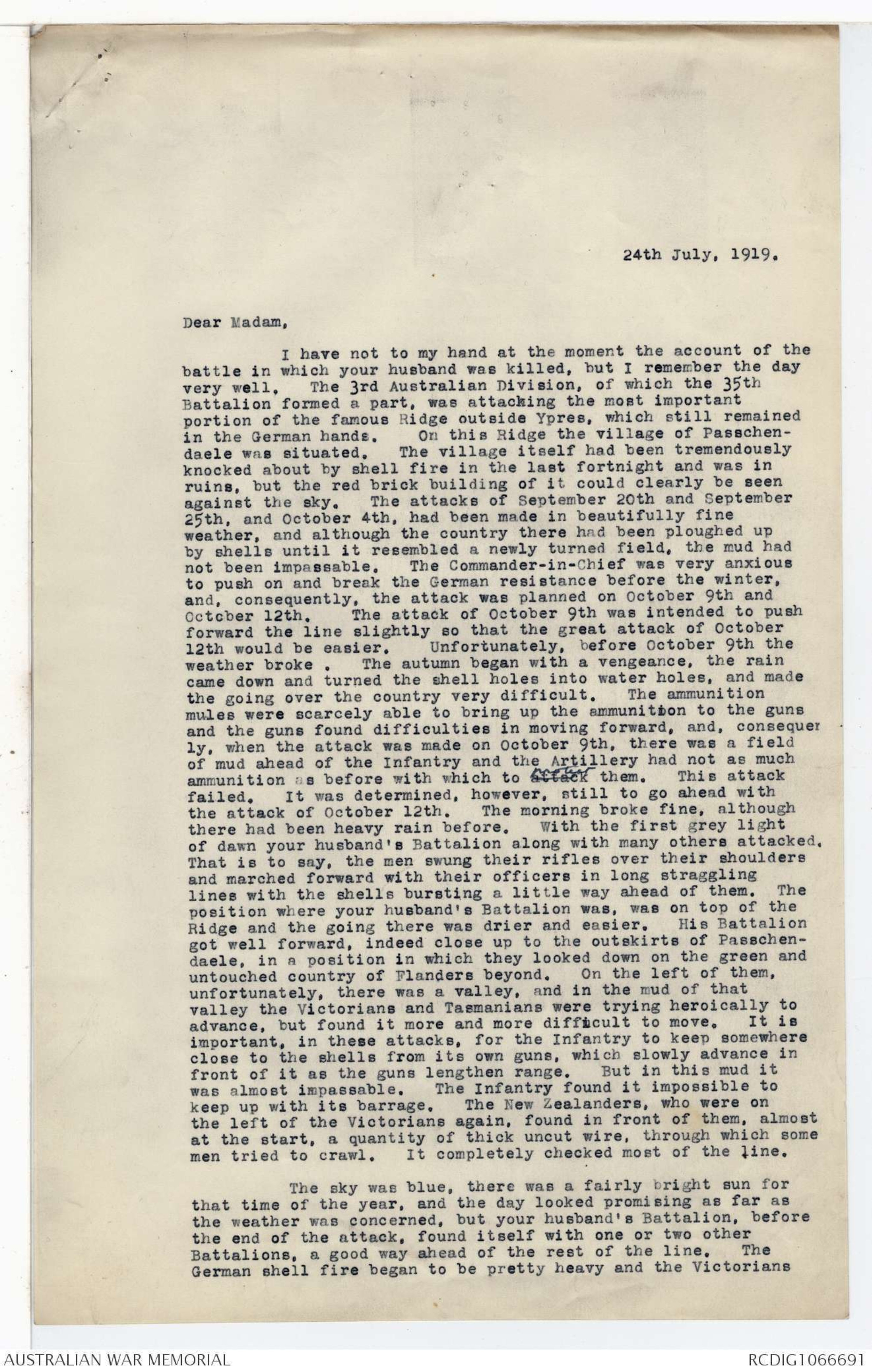
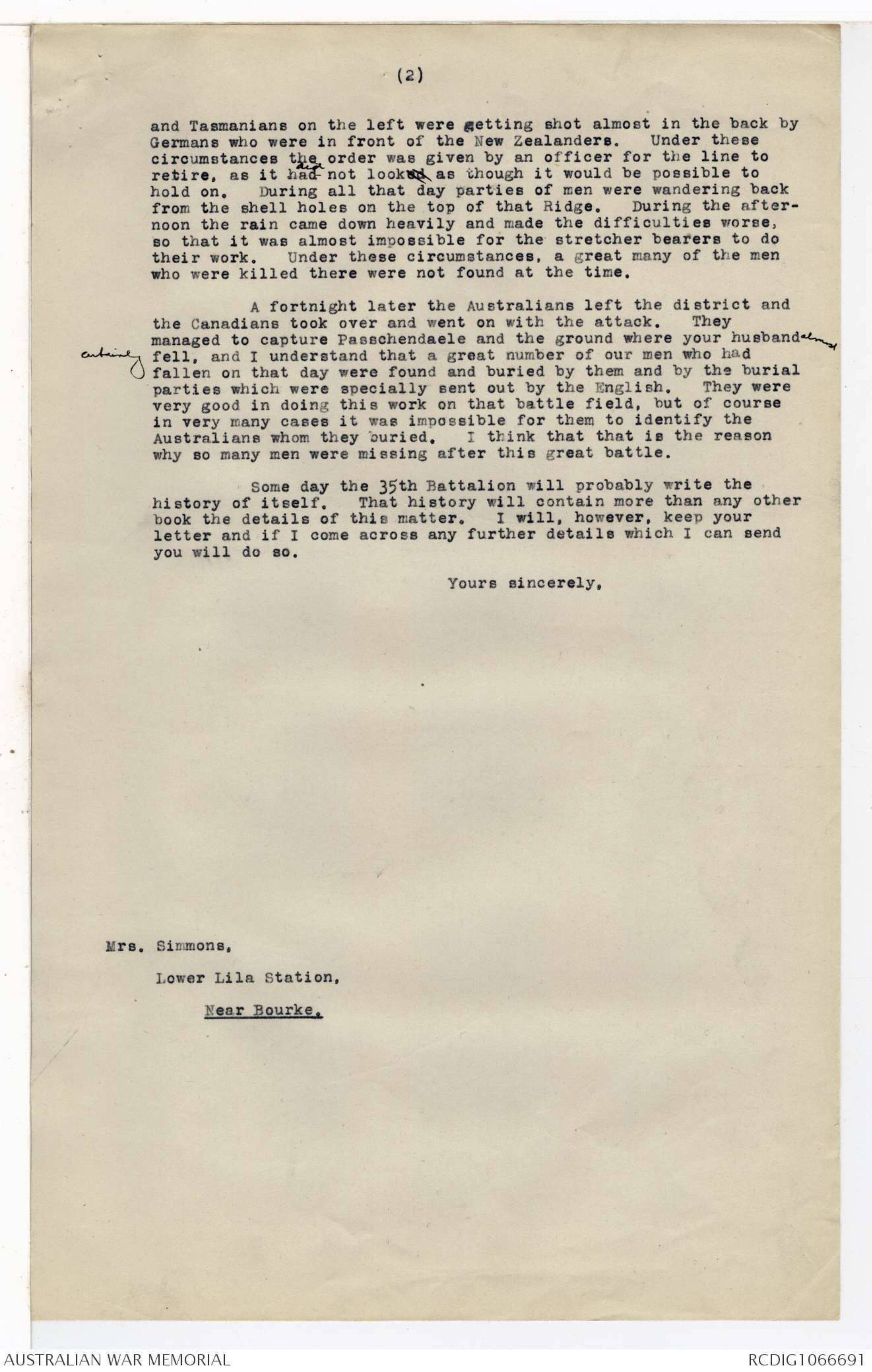
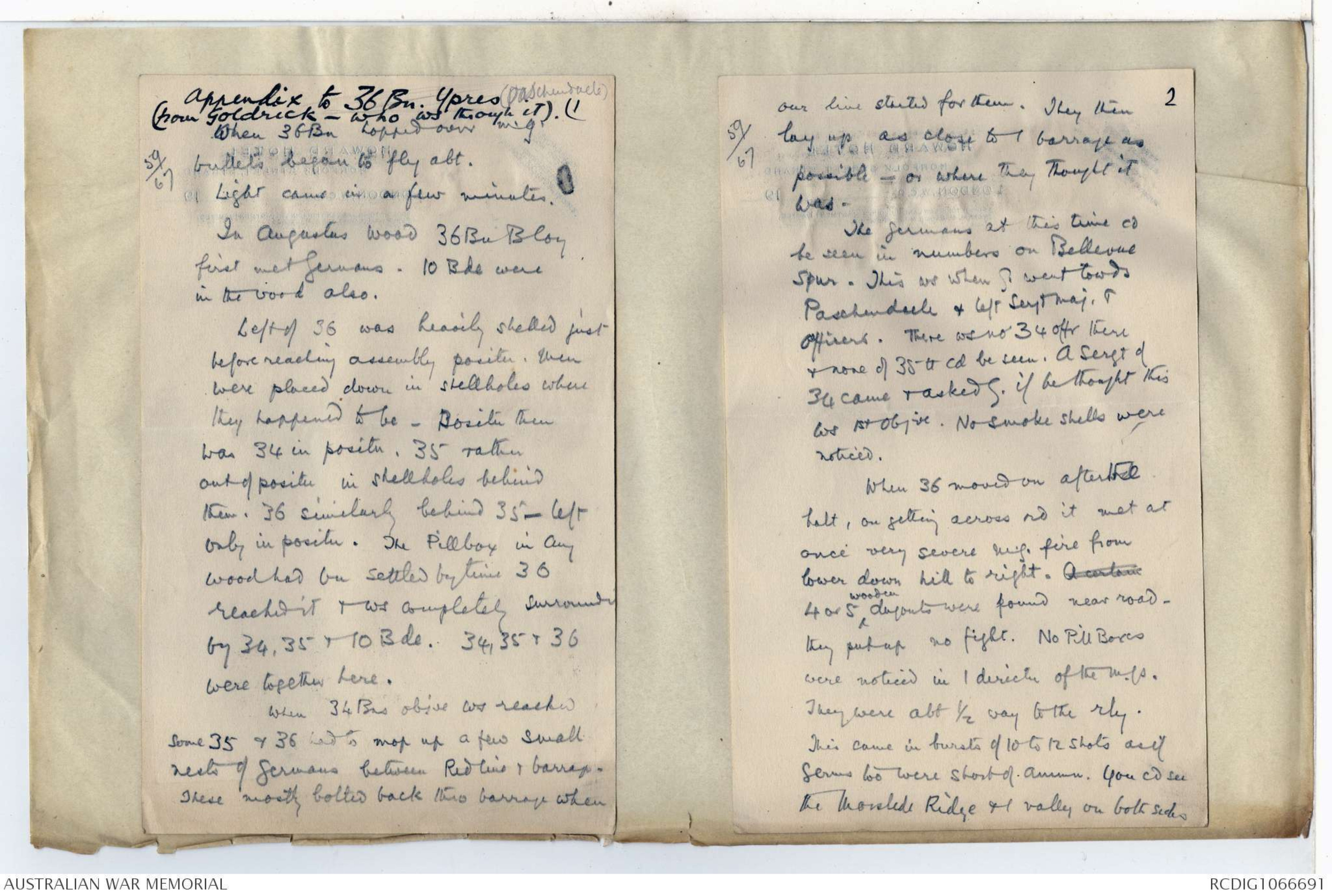
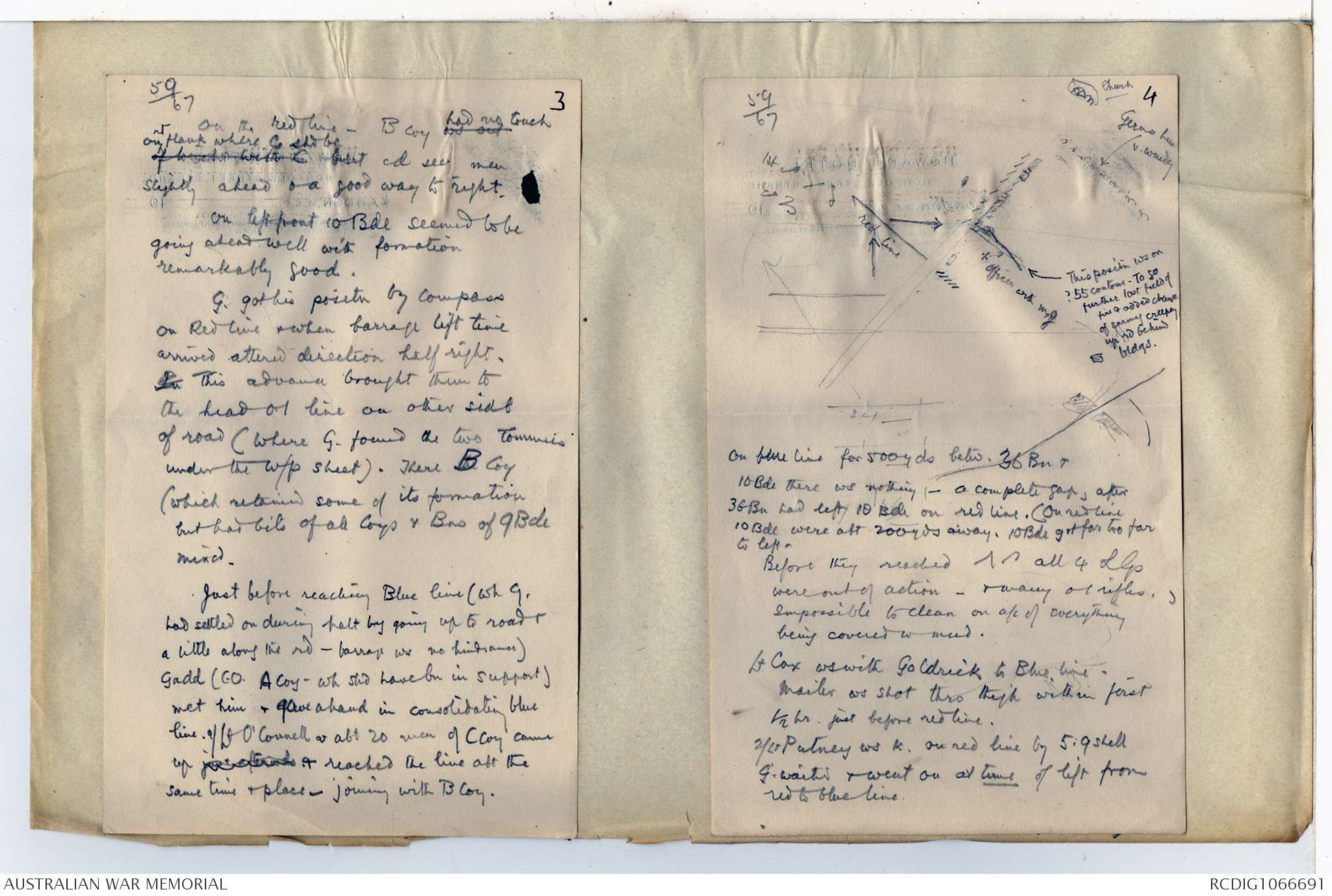
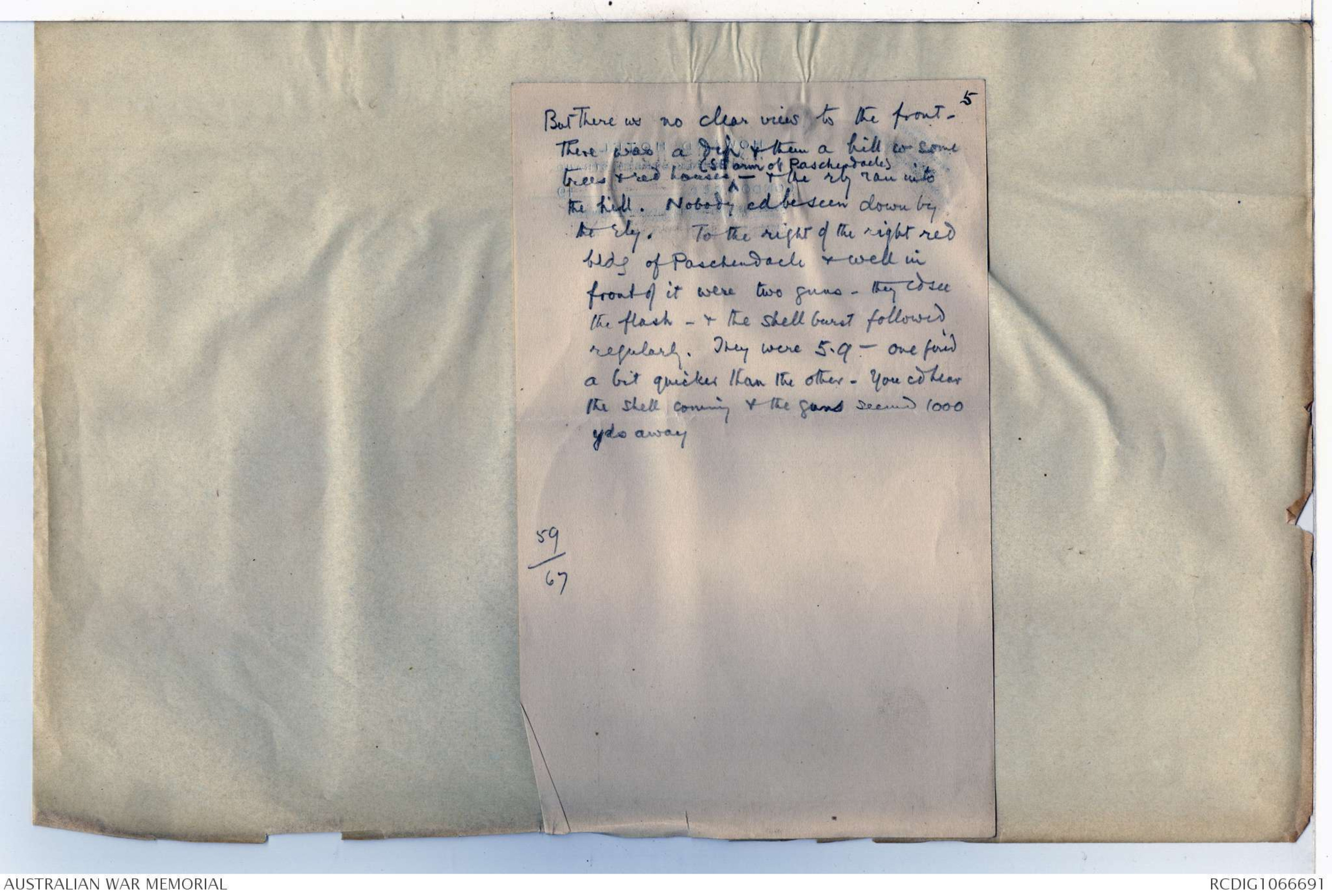
Oct 12/ 1917
Hawkins says that Carr was certainly in charge of
the line of the 35th at the moment when they retired at Paschendaele,
and apparently gave the order. He was in a very difficult
advanced position. Patterson and others who went back to Bn H.Q.
were not in a position to criticise him, Hawkins says. He does
not think that the order given by Carr can have been “Get for
your lives
Carr would not give an order like that. There was
another officer with the Bn at V/B who did give this order -a very
unsuitable officer, though not a bad man - he has since gone
back to Australia. Carrs HQ.at V/B was in the front line at 5.pm.
Trans further note to Book. 251
after Oct 12 chapter has been written
Corporal W. A Murray Methodist
Clergyman of the Newcastle Methodist Mission
was killed on 12/10/17 at Paschendaele
while serving with the 35 Bn..
According to his wife, when the
stretcher bearers came to collect
him he gave his place to a
comrade, & was xx never heard
of again.
Lower Lila Stn
near Bourke
19/7/19
To Mr Bean
Dear Sir
I saw in the Town &
Country weekly paper, that you were
watching our Australian soldiers in
their fight for Passchendaele on 12/10/17
my husband was reported “missing”
on that day, and eight months
after the military wrote and told
me that he had been killed on that
this report was based on a court of [[?]]
It is hard to believe him killed
as I have received nothing belonging
to him
I was wondering it you would be
so kind and let me know, something
of that battle, even now
[[my?]] little bays are asking me about
their Daddy, but I can tell them
nothing as I do not know,
my husband was Runner for A [[?]]
35th Battalion.Pt George Simmons No 2661
Capt Cadell, was the leader of his Company
but he was killed in that
day 12/10/14
I am very sorry to trouble you
but you will understand how
I hope for news of my dear husband
Hoping you can give me some
news
Yrs Sincerely
Nellie Simmons
Lower Lila Stn
near Bourke
13/10/19
To
Captain Bean
Dear Sir
Thank you
very much for the nice letter
you sent me telling me all
about the battle my dear
husband was reported missing
in.
I am sorry not to have
written to thank you before
but illness has kept me from
writing.
When my little sons are old.
enough to understand and read
your letter how proud they
will be of their Daddy to know
he fought and died so bravely
even though the help they needed
so badly did not come
again thanking you
I am
Yrs Sincerely
Nellie Simmons
24th July, 1919.
Dear Madam,
I have not to my hand at the moment the account of the
battle in which your husband was killed, but I remember the day
very well. The 3rd Australian Division, of which the 35th
Battalion formed a part, was attacking the most important
portion of the famous Ridge outside Ypres which still remained
in the German hands. On this Ridge the village of
Passchendaele was situated. The village itself had been tremendously
knocked about by shell fire in the last fortnight and was in
ruins, but the red brick building of it could clearly be seen
against the sky. The attacks of September 20th and September
25th. and October 4th, had been made in beautifully fine
weather, and although the country there had been ploughed up
by shells until it resembled a newly turned field, the mud had not been impassable. The Commander-in-Chief was very anxious
to push on and break the German resistance before the winter,
and, consequently, the attack was planned on October 9th and the attack of October 9th was intended to push
forward the line slightly so that the great attack of October 12th. would be easier. Unfortunately, before October 9th the weather broke. The autumn began with a vengeance, the rain
came down and turned the shell holes into water holes, and made
the going over the country very difficult. The ammunition mules were scarcely able to bring up the ammunition to the guns
and the guns found difficulties in moving forward, and, consequently when the attack was made on October 9th, there was a field
of mud ahead of the Infantry and the Artillery had not as much
ammunition as before with which to [[protect?]]them.
This attack
failed. It was determined, however, still to go ahead with
the attack of Oct 12th.The morning broke fine, although
there had been heavy rain before. With the first grey light
of dawn your husband's Battalion along with many others attacked.
That is to say, the men swung their rifles over their shoulders
and marched forward with their officers in long straggling
lines with the shells bursting a little way ahead of them. The
position where your husband's Battalion was, was on top of the
Ridge and the going there was drier and easier. His Battalion
got well forward, indeed close up to the outskirts of Passchendaele, in a position in which they looked down on the green and
untouched country of Flanders beyond. On the left of them,
unfortunately, there was a valley, and in the mud of that
valley the Victorians and Tasmanians were trying heroically to
advance, but found it more and more difficult to move. It is
important, in these attacks, for the Infantry to keep somewhere
close to the shells from its own guns, which slowly advance in
front of it as the guns lengthen range. But in this mud it
was almost impassable. The Infantry found it impossible to keep up with its barrage. The New Zealanders, who were on
the left of the Victorians again, found in front of them, almost
at the start, a quantity of thick uncut wire, through which some
men tried to crawl. It completely checked most of the line.
The sky was blue, there was a fairly bright sun for
that time of the year, and the day looked promising as far as
the weather was concerned, but your husband's Battalion, before
the end of the attack, found itself with one or two other
Battalions, a good way ahead of the rest of the line. The
German shell fire began to be pretty heavy and the Victorians
(2)
and Tasmanians on the left were getting shot almost in the back by
Germans who were in front of the New Zealanders. Under these
circumstances the order was given by an officer for the line to
retire, as it had not looked as though it would be possible to hold on. During all that day parties of men were wandering back.
During the afternoon the rain came down heavily and made the difficulties worse,
from the shell holes on the top of that Ridge.
so that it was almost impossible for the stretcher bearers to do their work.
Under these circumstances, a great many of the men
who were killed there were not found at the time.
A fortnight later the Australians left the district and
the Canadians took over and went on with the attack.
They managed to capture Paschendaele and the ground where your husband
fell, and 1 understand that a great number of our men who had
fallen on that day were found and buried by them and by the burial
parties which were specially sent out by the English. They were
very good in doing this work on that battle field, but of course
in very many cases it was impossible for them to identify the
Australians whom they buried. I think that that is the reason
why so many men were missing after this great battle.
Some day the 35th Battalion will probably write the
the history of itself. That history will contain more than any other
book the details of this matter.
1 will, however, keep your
letter and if 1 come across any further details which I can send
you will do so.
Yours sincerely,
Mrs. Simmons,
Lower Lila Station,
Near Bourke.
59/67
Appendix to 36 Bn. Ypres (Paschendaele)
(from Goldrick - who ws through it). (1
When 36 Bn hopped over m.g.s
59/67 bullets began to fly abt.
Light came in a few minutes.
In Augustas Wood 36 Bn B Coy
first met Germans. 10 Bde were
in the wood also.
Left of 36 was heavily shelled just
before reaching assembly position.Then
were placed down in stellholes where
they happened to be - position then
was 34 in position, 35 rather
out of position in shellholes behind
them. 36 similarly behind 35 - left
only in position. The Pillbox in Aug
Wood had bn settled by time 36
reached it & we completely surrounded
by 34,35 & 10 Bde.. 34,35 & 36
were together here.
When 34 Bns objve ws reached
some 35 & 36 had to mop up a few small
nests of Germans between Red Line & barrage.
These mostly bolted back thro barrage when
59/67
2
our line started for them. They then
lay up as close to / barrage as
possible - or where they thought it
was.
The Germans at this time cd
be seen in numbers on Bellevue
Spur. This ws when I went towds
Paschendaele & left Sergt Major, &
Officers. There ws no 34 offfr there
& none of 35 tt cd be seen. A Sergt of
34 came & asked if he thought this
ws 1st obj. No smoke shells were
noticed.
When 36 moved on after the
halt, on getting across rd it met at
once very severe mg. fire from
lower down hill to right. Xxxxx
4 or 5 ^wooden dugouts were found near road-
they put up no fight. No Pill Boxes
were noticed in /direction of the M.gs.
They were abt 1/2 way to the rly.
This came in bursts of 10 to 12 shots and
Germs too were short of Amun. You cd see
the Morslede Ridge & valley on both sides.
59/67
3
On the red Line - B Coy xxxxx had mg touch
xxxxxxxxxxx on 5 flank where C cd see men
slightly ahead and a good way to right.
On left support 10 Bde seemed to be
going ahead well with formation
remarkably good.
G got his position by compass
on Red Line & when barrage [[left time?]]
arrived altered direction half right.In This advance brought them to
the head of line on other side
of road (where G. found the two Tommies
under the w/p sheet). There B. Coy
(which returned some of its formation
but had bits of all Coys & Bns of 9Bde
mixed.
Just before reaching Blue line (wh G.
had settled on during halt by going up to road &
a little along the rd - barrage ws no hindrance)
Gadd (CO. A Coy - wh shd have bn in support)
met him & glve [[?]] a hand in consolidating blue
line of Lt O’Connell & abb 20 men of C Coy came
up xxxxx & reached the line abt the
same time & place - joining with B Coy.
Diagram- see original document
On blue line for 500 yds betw. 36 Bn &
10 Bde were at 200 yds away. 10 Bde got far to far
to left.
Before they reached [shorthand] all 4 LGs
were out of action - + many of rifles,
Impossible to clean on acc of everything
being covered in mud.
Lt Cox ws with Goldrick Blue line.
Mailer as shot thro thigh within first
1/2 hr just before red line.
2/Lt Pudney ws k. On red line by 5.9 she’ll
I waited & went on at time of left from
red to blue line.
5
But there us no clear view to the front.
there head a dip & then a hill to some
trees & red houses ^[[?]] of Paschendaele) & the rly ran into
the hill. Nobody cd be seen down by
the rly. To the right of the right red
bldg of Paschendaele & well in
front of it were two guns - they cd see
the flash - the shell burst followed
regularly. They were 5.9 - one firex
a bit quicker than the other - you cd hear
the shell coming & the guns seemed 1000
yds away
59 /67
 Sam scott
Sam scottThis transcription item is now locked to you for editing. To release the lock either Save your changes or Cancel.
This lock will be automatically released after 60 minutes of inactivity.